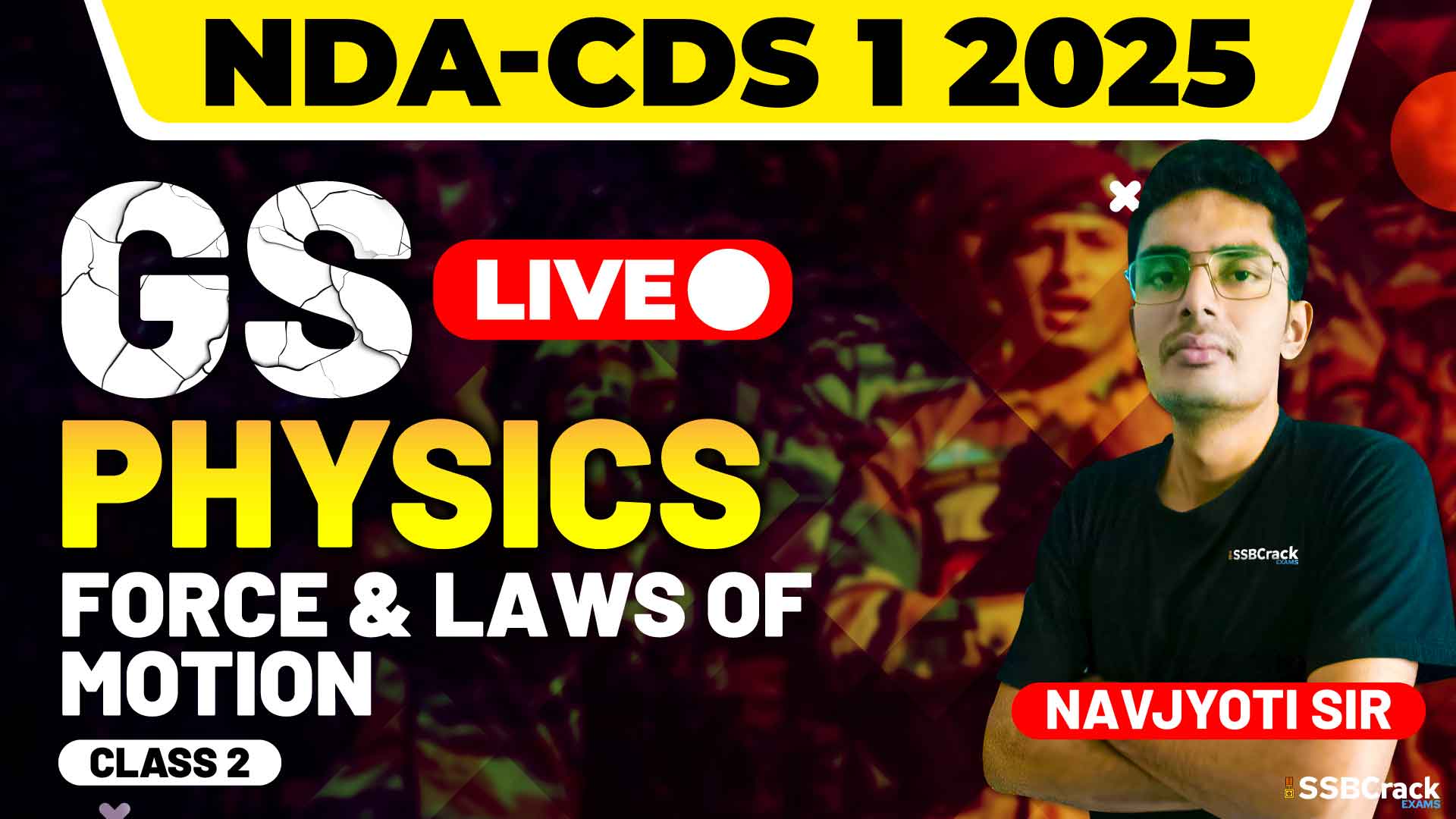The Laws of Motion is one of the most fundamental and high-scoring topics in the Physics section of the National Defence Academy and Naval Academy (NDA-NA) Exam – Paper II (GAT) and the GK Paper of the Combined Defence Services (CDS) Exam. To strengthen the preparation of aspirants, a recent class was conducted entirely based on the practice of Multiple Choice Questions (MCQs) – both from previous years’ papers and expected ones related to the topic.
This practice-focused session aimed at building speed, accuracy, and confidence among the students. Laws of Motion, being a conceptual topic, often involves theoretical reasoning as well as application-based questions. Let us dive into the details of the class and strategies to prepare for this topic effectively.
Details of the Class
The class was meticulously planned to provide a hands-on approach to solving questions under the Laws of Motion. It catered to three main objectives:
- Strengthening Conceptual Clarity: Revisiting key ideas and terms while solving MCQs.
- Exposure to Previous Years’ Questions: Familiarizing students with the actual exam patterns.
- Practice of Expected Questions: Preparing for anticipated questions to tackle the unpredictable nature of competitive exams.
Topics Covered in MCQs
The class focused on solving questions from the subtopics of Laws of Motion:
- Newton’s Laws of Motion: Questions on the first, second, and third laws with practical examples.
- Inertia and Momentum: Identifying scenarios that highlight inertia and understanding how momentum is conserved in different conditions.
- Force and Impulse: Problems where force acts for a limited time, requiring students to analyze cause-effect relationships.
- Friction: Questions involving static and kinetic friction, real-world applications, and conditions to overcome friction.
- Other Forces: Problems related to tension, weight, and normal reaction in equilibrium and non-equilibrium conditions.
- Conservation of Momentum: Solving application-based MCQs involving collisions and isolated systems.
Class Flow
- Discussion of Key Concepts
- Before jumping into the questions, a quick revision of essential concepts like inertia, types of forces, and Newton’s Laws was provided. This recap helped students recall previously studied material.
- Step-by-Step Question Solving
- Each question was solved systematically. For theoretical questions, logic and reasoning were emphasized, while for scenario-based ones, diagrams and free-body representations were discussed.
- After each question, the reasoning behind the correct answer was explained clearly, highlighting any trick or conceptual trap involved.
- Timed Practice
- Students were given sets of questions to solve within a fixed time frame. This helped improve time management, an essential skill for competitive exams.
- Doubt-Clearing Session
- A significant portion of the class was dedicated to resolving doubts and clarifying confusing concepts related to specific questions.
The emphasis throughout the session was not just on solving questions but also on understanding the logic behind each answer.
Strategies to Prepare Laws of Motion for NDA-NA and CDS
1. Strengthen the Fundamentals
The Laws of Motion is a conceptual topic, and clarity in basics is essential. Focus on:
- Newton’s Three Laws and their applications in real life.
- Understanding terms like inertia, force, momentum, and impulse.
- Differentiating between various forces like tension, weight, normal reaction, and friction.
2. Break Down the Concepts
Make concise notes summarizing each subtopic under Laws of Motion. For example:
- Inertia: Types of inertia – inertia of rest, motion, and direction.
- Friction: Types of friction, conditions to reduce or increase it, and practical applications.
Breaking concepts into small, manageable points will help during revision.
3. Practice Previous Years’ MCQs
- Solve as many past year questions as possible to familiarize yourself with the exam pattern.
- Focus on understanding the logic behind each correct option instead of memorizing answers.
- Analyze the recurring types of questions to prioritize key subtopics.
4. Time Management Through Practice
Competitive exams like NDA-NA and CDS are time-bound, so practicing under a timer is essential.
- Solve mock tests and practice sets regularly.
- Time yourself for every section and gradually reduce the time taken to answer questions accurately.
5. Use Diagrams and Free-Body Representation
For questions involving forces, free-body diagrams can simplify complex problems.
- Draw diagrams for forces like tension, weight, and normal reaction to visualize the problem better.
- Practice applying concepts of equilibrium and net force in these diagrams.
6. Real-Life Applications
Relate Newton’s Laws and concepts like inertia and friction to real-world scenarios. For example:
- Why passengers jerk forward when a car stops suddenly (Inertia).
- Why walking on ice is difficult (Friction).
- How rockets launch into space (Conservation of Momentum).
Understanding practical applications makes it easier to remember concepts and answer questions effectively.
7. Consistent Revision
- Review the topic regularly to retain key concepts.
- Create short notes highlighting definitions, types of forces, and essential laws for quick revision before the exam.
8. Attempt Mock Tests and Analyze Performance
- Attempt full-length mock papers to test your understanding and readiness.
- Analyze mistakes, especially in conceptual or tricky questions, and work on weak areas.
9. Focus on Doubt Resolution
Never leave doubts unresolved. Discuss confusing questions with mentors, peers, or use reference material to clarify your understanding.
Why Focus on Laws of Motion?
- High Scoring Topic:
- Questions from Laws of Motion are concept-based and often straightforward, making it a scoring area for students.
- Foundational for Advanced Topics:
- The principles learned here serve as the foundation for Work, Energy, Power, and Rotational Motion, which are also key topics in physics.
- Direct Real-Life Application:
- The laws explain everything from simple movements to complex phenomena like rocket propulsion.
- Frequent in Exams:
- Newton’s Laws, friction problems, and conservation of momentum are frequently asked in both NDA-NA and CDS exams.
Conclusion
The recent practice-oriented class on Laws of Motion was a valuable opportunity for aspirants to solidify their understanding and enhance their problem-solving skills. Through focused practice of MCQs from previous years and anticipated questions, students learned to approach questions logically, manage their time efficiently, and avoid common pitfalls.
To excel in the NDA-NA and CDS exams, aspirants must focus on understanding concepts, regular practice, and time-bound solving. By adopting a strategic preparation approach, this topic can become a scoring advantage, ensuring better performance in the physics section.
With dedication, clarity, and consistent practice, mastering the Laws of Motion is well within reach. Remember, persistence and discipline are key to success in any competitive exam. Stay focused, keep practicing, and success will follow.



















